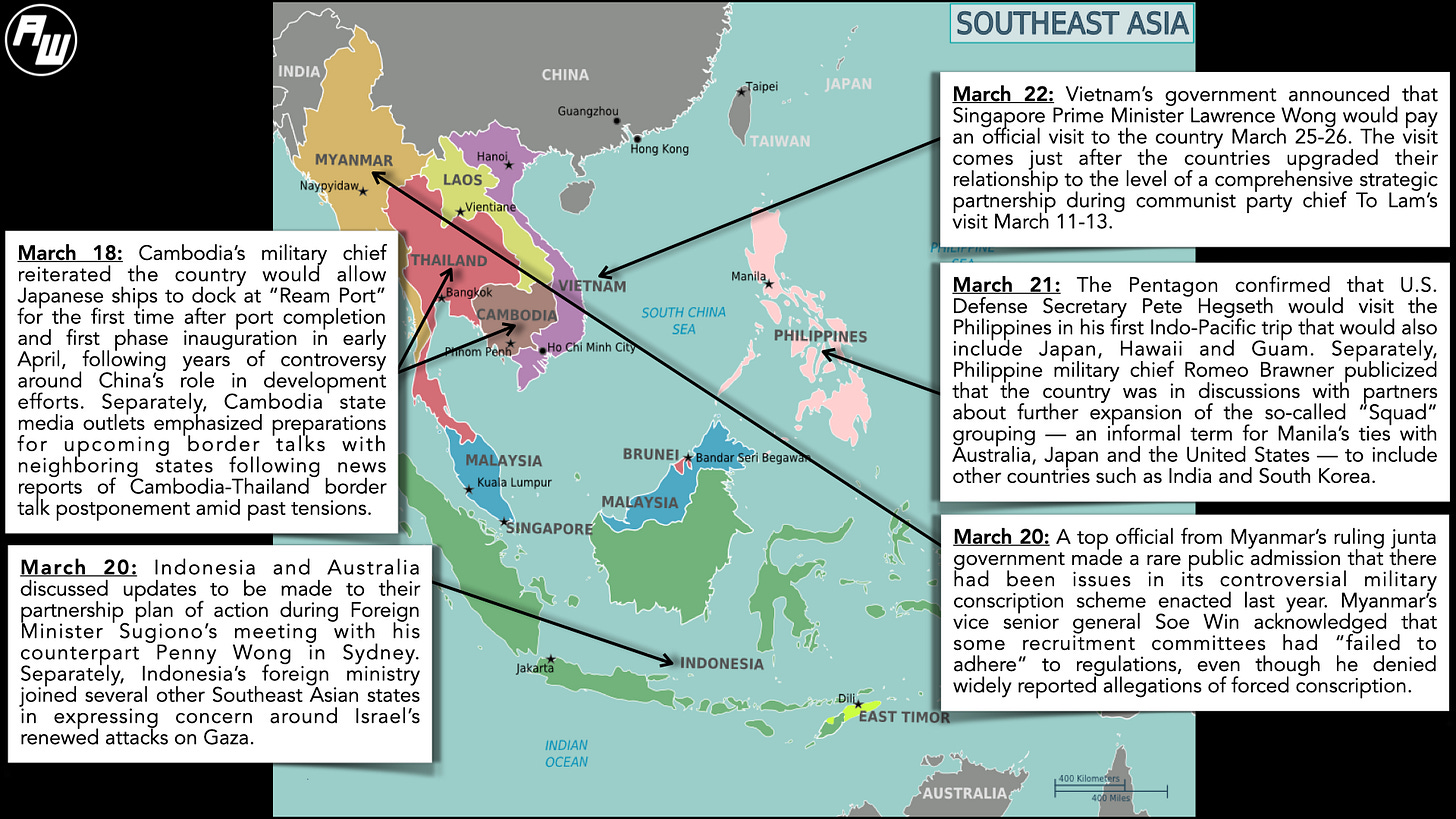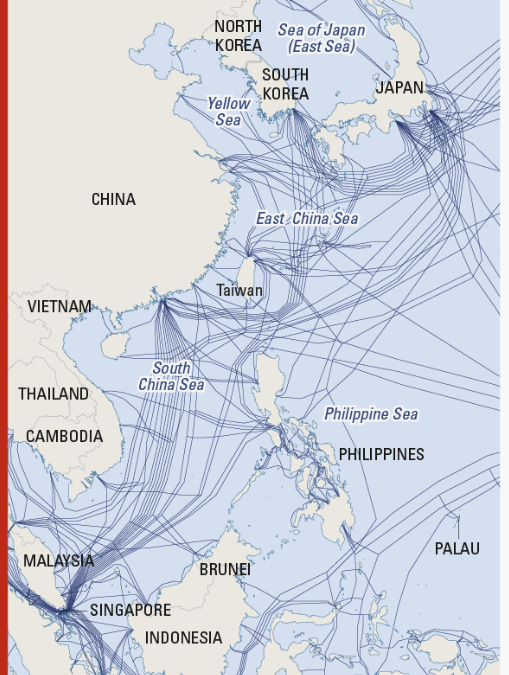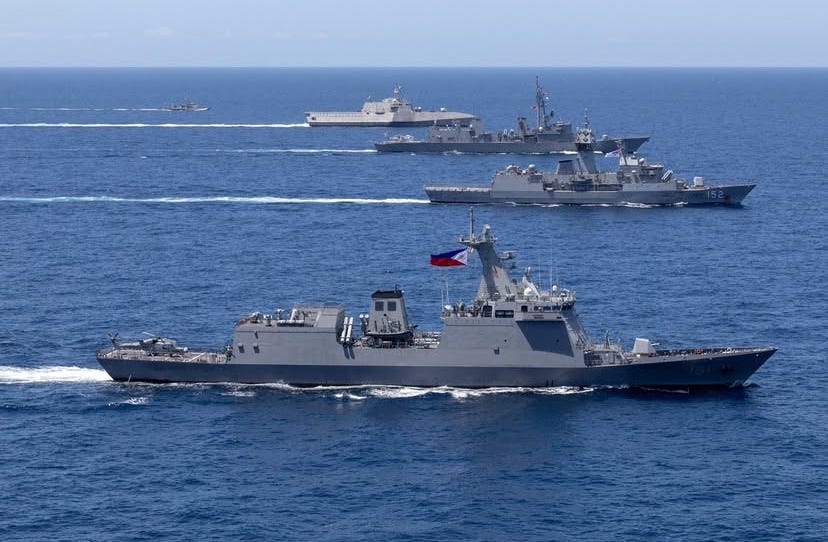Squad Minilateral Expansion Reveal at Raisina Dialogue 2025
Plus inaugural Indo-Pacific voyage; new nuclear deal; twin counter cyber commands; critical minerals pact talk; coming maritime strategy and much, much more.
Greetings to new readers and welcome all to the latest edition of the weekly ASEAN Wonk BulletBrief! If you haven’t already, you can upgrade to a paid subscription for $5 a month/$50 a year below to receive full posts by inserting your email address and then selecting an annual or monthly option. You can visit this page for more on pricing for institutions, groups as well as discounts. For current paid subscribers, please make sure you’re hitting the “view entire message” prompt if it comes up at the end of a post to see the full version.
For this iteration of ASEAN Wonk BulletBrief, we are looking at:
Assessing the geopolitical and geoeconomic significance of “Squad” minilateral security expansion prospects and wider regional and global implications following new details publicized at the Raisina Dialogue 2025;
Mapping of regional developments, including inaugural Indo-Pacific voyage; coming port engagements and partnership upgrade summitry;
Charting evolving geopolitical, geoeconomic and security trends such as new nuclear deal; twin counter cyber commands and coming national maritime sector strategy;
Tracking and analysis of industry developments and quantitative indicators including fresh critical minerals pact talk; future regional geoeconomic scenarios and big infrastructure upgrade plan;
And much more! ICYMI, check out our new ASEAN Wonk Podcast episode featuring one of the key architects of South Korea’s Southeast Asia strategy and the country’s former trade minister.
This Week’s WonkCount: 2,178 words (~10 minutes)
Inaugural Indo-Pacific Voyage; Coming Port Engagements & More

Critical Maritime Infrastructure; Targeting Interoperability & Multidimensional Engagement Future
“As China’s interests in the near seas, far seas and undersea domain grow, so too will PLAN and CCG capabilities geared towards protecting the infrastructure elements integral to the Chinese state,” notes a new guide published by the International Institute for Strategic Studies that examines China’s approach to critical maritime infrastructure protection. The report notes that undersea cables have taken center-stage in Beijing’s thinking in recent years due to a series of developments including the focus of the Belt and Road Initiative on digital economy and supply chain reorientation (link).
Depiction of Key Undersea Asia-Pacific Cable Networks
“The regional latticework approach requires Australia to think about the concept of interoperability with its Southeast Asian partners through a new lens,” observes a new paper published by the the University of Western Australia Defense and Security Institute. The paper delves into the specifics of conceptualizing interoperability, including through a spectrum derived from the Royal Australian Air Force (RAAF) Air Power manual (link).
Illustration of RAAF-Derived Interoperability Spectrum
“India’s approach should be multidimensional, balancing humanitarian, economic, and diplomatic initiatives,” argues a new commentary charting out a roadmap for Indian engagement with Myanmar published by the Asia-Pacific Center for Security Studies. The commentary suggests that the engagement roadmap for India in Myanmar should consist of four main aspects: 1) humanitarian support; 2) strategic partnerships; 3) economic engagement; and 4) diplomatic advocacy (link).
Squad Minilateral Expansion Reveal at Raisina Dialogue 2025
What’s Behind It
The Philippines’ military chief publicized ongoing discussions to include more partner countries in the so-called “Squad” — an informal term for minilateral networking between Manila along with Australia, Japan and the United States at a key forum in New Delhi1. The spotlight on the Squad came amid yet another active week for the Philippines in its engagements. In New Delhi, the foreign ministers of the Philippines and India met amid speculation around the timing of a visit by President Ferdinand Marcos Jr, which ASEAN Wonk understands had been floated since earlier last year2. Meanwhile, the Pentagon disclosed Defense Secretary Pete Hegseth would be in the Philippines during his first Indo-Pacific trip, part of a series of visits Philippine officials have been trying to work through3. At home, Marcos and his presidential office reinforced the importance of the cyber domain and countering misinformation as the Philippine Army celebrated its anniversary and the country dealt with the aftermath of ex-president Rodrigo Duterte’s dramatic arrest and departure to The Hague4.
Select Key Recent Geopolitical and Geoeconomic Developments Related to the Philippines
The revelation occurred as the minilateral agenda is being shaped for 2025. The emphasis has been on continuity with respect to institutions like the Quad, with foreign ministers engaging just after the new administration under U.S. President Donald Trump took office. Beyond that, some Indo-Pacific states including the Philippines have also been trying to find geoeconomic touchpoints to engage the new administration early on beyond geopolitical concerns that include the challenge from China. Philippine officials have said that getting an early start in engaging the Trump administration could provide a way to shape the evolving approach to the so-called “latticework” given what one official characterized to ASEAN Wonk as Manila’s role as not only “the most contributing” security partner for the United States in Southeast Asia but also “the most promising” economic prospect (a reference to the fact that Manila is by some estimates the second fastest-growing economy in ASEAN after Vietnam)5. There have also been conversations around how to build out relatively newer mechanisms such as the “Squad” beyond periodically publicized exercises that have continued in the first quarter of 20256. Officials have also previously floated the expansion of newer minilaterals to include more “like-minded” partners, even though these proposals have not made as many headlines7.
Why It Matters
The revelation also shed light on key developments and details in the broader set of new major developments and future datapoints to watch in the Philippines’ major partnerships (see originally generated ASEAN Wonk table below on notable indicators and additional specifics. Paying subscribers can read on for more on what to expect and future implications in the rest of the “Why It Matters” and “Where It’s Headed” sections, along with paid-only sections of the newsletter as usual).











